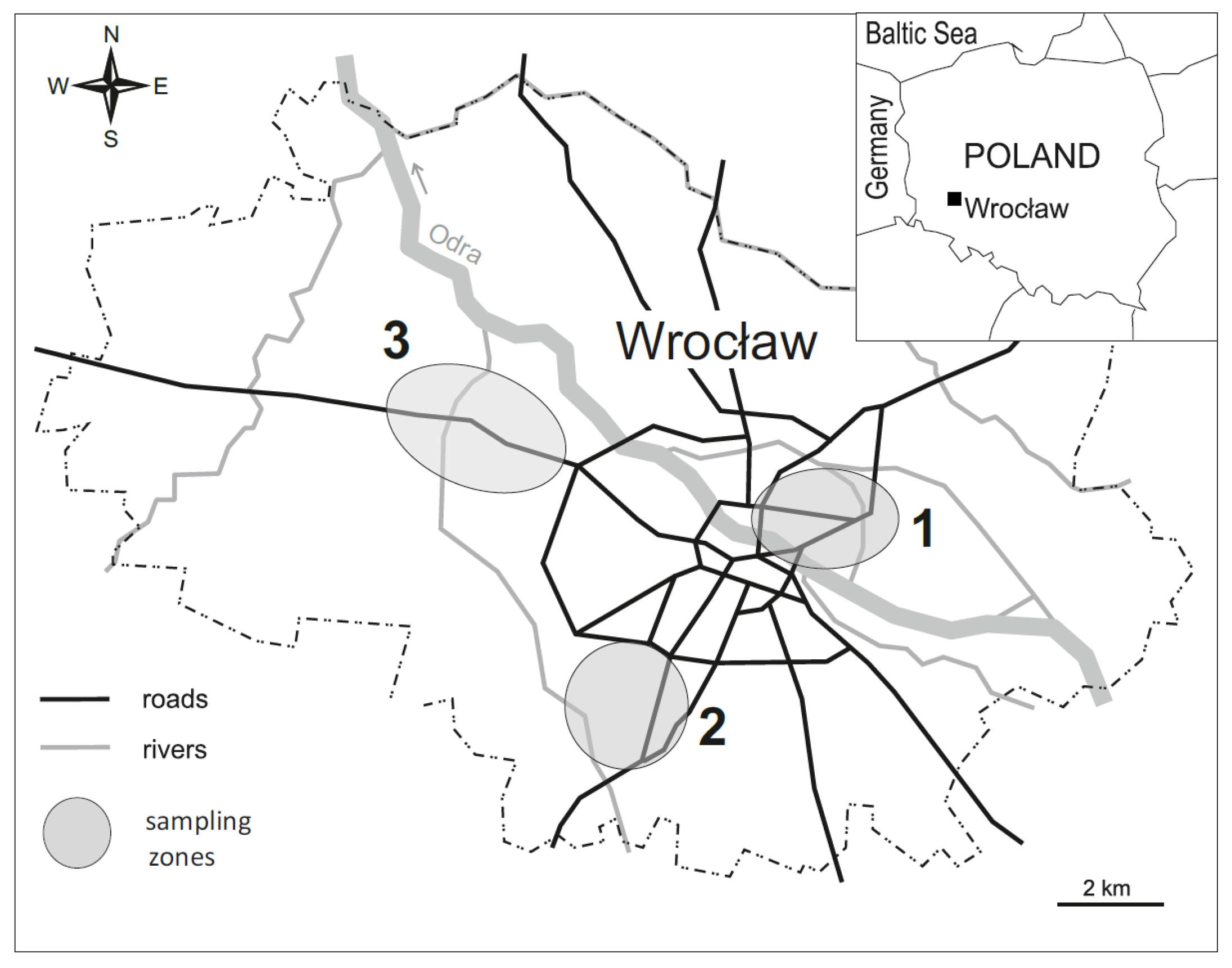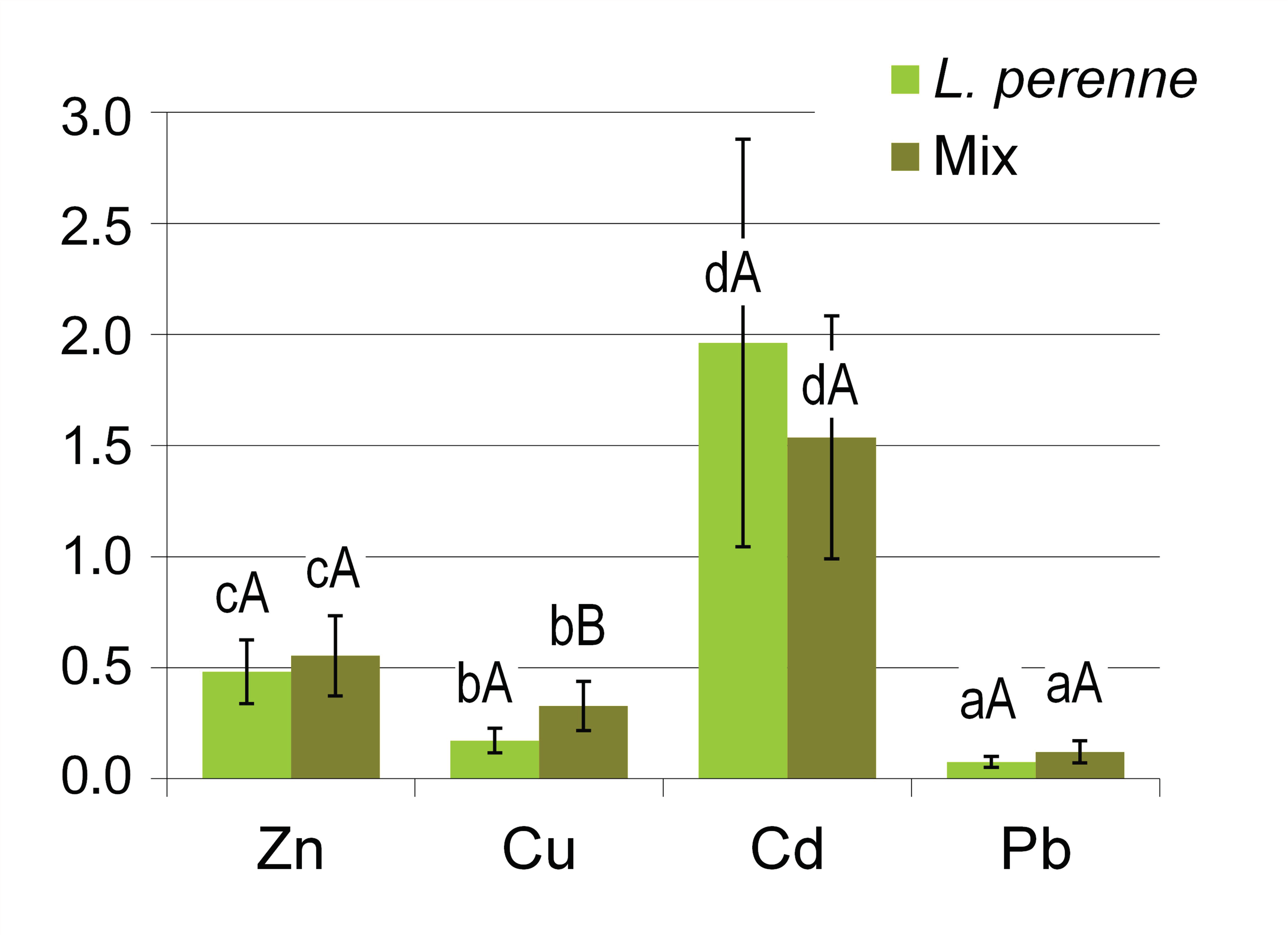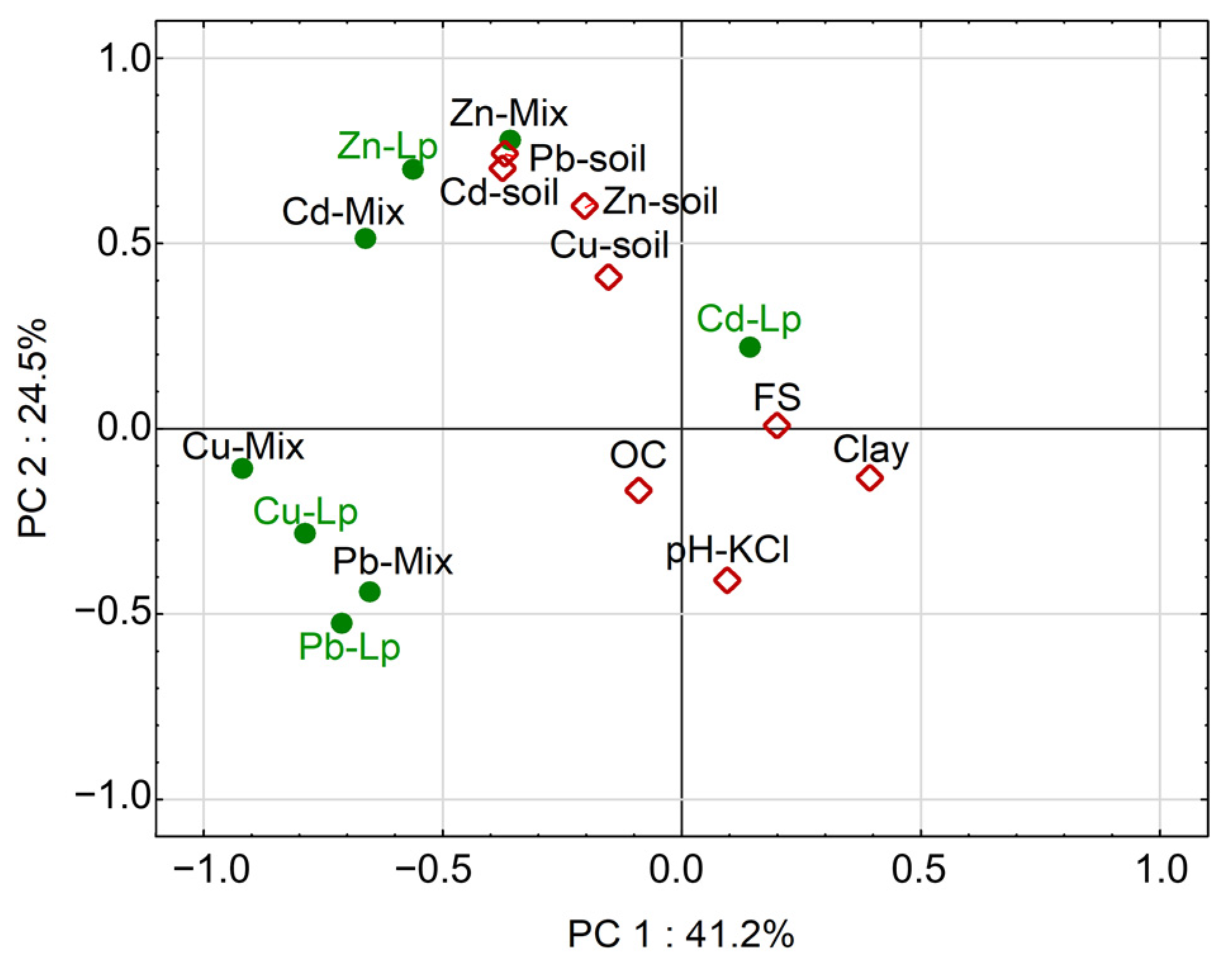Accumulation of Potentially Toxic Metals in Ryegrass (Lolium perenne, L.) and Other Components of Lawn Vegetation in Variously Contaminated Sites of Urban Areas
Abstract
:1. Introduction
2. Materials and Methods
2.1. Study Sites
2.2. Soil and Plant Sampling and Preparation
2.3. Soil Analysis
2.4. Plant Analysis
2.5. Statistics
3. Results and Discussion
4. Conclusions
Author Contributions
Funding
Institutional Review Board Statement
Informed Consent Statement
Data Availability Statement
Conflicts of Interest
References
- Okeke, F.O.; Eziyi, I.O.; Udeh, C.A.; Ezema, E.C. City as Habitat: Assembling the fragile city. Civil Eng. J. 2020, 6, 1143–1154. [Google Scholar] [CrossRef]
- Sun, L.; Chen, J.; Li, Q.; Huang, D. Dramatic uneven urbanization of large cities throughout the world in recent decades. Nature Comm. 2020, 11, 5366. [Google Scholar] [CrossRef]
- Petrova, S.; Nikolov, B.; Velcheva, I.; Angelov, N.; Valcheva, E.; Katova, A.; Golubinova, I.; Marinov-Serafimov, P. Buffer green patches around urban road network as a tool for sustainable soil management. Land 2022, 11, 343. [Google Scholar] [CrossRef]
- Ignatieva, M.; Haase, D.; Dushkova, D.; Haase, A. Lawns in cities: From a globalised urban green space phenomenon to sustainable nature-based solutions. Land 2020, 9, 73. [Google Scholar] [CrossRef]
- Mathew, S. Role of turfgrass in urban landscapes. J. Plant Dev. Sci. 2021, 13, 247–255. [Google Scholar]
- O’Riordan, R.; Davies, J.; Stevens, C.; Quinton, J.; Boyko, C. The ecosystem services of urban soils: A review. Geoderma 2021, 395, 115076. [Google Scholar] [CrossRef]
- Winkler, J.; Koda, E.; Červenková, J.; Děkanovský, I.; Nowysz, A.; Mazur, Ł.; Jakimiuk, A.; Vaverková, M.D. Green space in an extremely exposed part of the city center “Aorta of Warsaw”-Case study of the urban lawn. Urban Ecosyst. 2023, 26, 1225–1238. [Google Scholar] [CrossRef]
- Wang, M.; Liu, R.; Chen, W.; Peng, C.; Markert, B. Effects of urbanization on heavy metal accumulation in surface soils. J. Environ. Sci. 2018, 64, 328–334. [Google Scholar] [CrossRef]
- Silva, H.F.; Silva, N.F.; Oliveira, C.M.; Matos, M.J. Heavy metals contamination of urban soils—A decade study in the city of Lisbon, Portugal. Soil Syst. 2021, 5, 27. [Google Scholar] [CrossRef]
- Bakhmatova, K.A.; Matynyan, N.N.; Sheshukova, A.A. Anthropogenic soils of urban parks: A review. Eur. Soil Sci. 2022, 55, 64–80. [Google Scholar] [CrossRef]
- Tang, S.; Wang, C.; Song, J.; Ihenetu, S.C.; Li, G. Advances in Studies on Heavy Metals in Urban Soil: A Bibliometric Analysis. Sustainability 2024, 16, 860. [Google Scholar] [CrossRef]
- Sarwar, N.; Imran, M.; Shaheen, M.R.; Ishaque, W.; Kamran, M.A.; Matloob, A.; Rehim, A.; Hussain, S. Phytoremediation strategies for soils contaminated with heavy metals: Modifications and future perspectives. Chemosphere 2017, 171, 710–721. [Google Scholar] [CrossRef]
- Shackira, A.M.; Puthur, J.T. Phytostabilization of Heavy Metals: Understanding of Principles and Practices. In Plant-Metal Interactions; Srivastava, S., Srivastava, A., Suprasanna, P., Eds.; Springer: Cham, Switzerland, 2019; pp. 263–282. [Google Scholar] [CrossRef]
- Karczewska, A.; Mocek, A.; Goliński, P.; Mleczek, M. Phytoremediation of copper-contaminated soil. In Phytoremediation: Management of Environmental Contaminants; Ansari, A., Gill, S., Gill, R., Lanza, G., Newman, L., Eds.; Springer: Cham, Switzerland, 2015; Volume 2, pp. 143–170. [Google Scholar] [CrossRef]
- Bidar, G.; Garçon, G.; Pruvot, C.; Dewaele, D.; Cazier, F.; Douay, F.; Shirali, P. Behavior of Trifolium repens and Lolium perenne growing in a heavy metal contaminated field: Plant metal concentration and phytotoxicity. Environ. Poll. 2007, 147, 546–553. [Google Scholar] [CrossRef] [PubMed]
- Arienzo, M.; Adamo, P.; Cozzolino, V. The potential of Lolium perenne for revegetation of contaminated soil from a metallurgical site. Sci. Total Environ. 2004, 319, 13–25. [Google Scholar] [CrossRef]
- Alvarenga, P.; Gonçalves, A.P.; Fernandes, R.M.; de Varennes, A.; Vallini, G.; Duarte, E.; Cunha-Queda, A.C. Evaluation of composts and liming materials in the phytostabilization of a mine soil using perennial ryegrass. Sci. Total Environ 2008, 406, 43–56. [Google Scholar] [CrossRef] [PubMed]
- Sarathchandra, S.S.; Rengel, Z.; Solaiman, Z.M. Remediation of heavy metal-contaminated iron ore tailings by applying compost and growing perennial ryegrass (Lolium perenne L.). Chemosphere 2022, 288, 132573. [Google Scholar] [CrossRef]
- Masotla, M.K.L.; Melato, F.A.; Mokgalaka-Fleischmann, N.S. Extraction Potential of Lolium perenne L.(Perennial Rye Grass) for Metals in Landfill Soil: Its Tolerance and Defense Strategies. Minerals 2023, 13, 873. [Google Scholar] [CrossRef]
- Akdeniz, H.; Hosaflıoğlu, İ. Effects of nitrogen fertilization on some turfgrass characteristics of perennial ryegrass (Lolium perenne L.). J. Agric. Sci. Technol. B 2016, 6, 226–237. [Google Scholar] [CrossRef]
- Braun, R.C.; Patton, A.J. Perennial ryegrass (Lolium perenne) culm and inflorescence density in lawns: Effects of nitrogen fertilization and scalping timing and height. Crop Sci. 2022, 62, 489–502. [Google Scholar] [CrossRef]
- Klimont, K.; Bulińska-Radomska, Z.; Osińska, A.; Bajor, P. Formation of species composition of plants introduced and spontaneously settled on a fertilized municipal waste dump. Biul. Inst. Hod. Aklimat. Roślin 2013, 270, 109–121. (In Polish) [Google Scholar] [CrossRef]
- Rabêlo, F.H.; Borgo, L.; Lavres, J. The use of forage grasses for the phytoremediation of heavy metals: Plant tolerance mechanisms, classifications, and new prospects. In Phytoremediation. Methods, Management and Assessment; Matichenkov, V., Ed.; Nova Science Publishers, Inc.: New York, NY, USA, 2018; Chapter 3; pp. 59–103. [Google Scholar]
- Zhang, J.; Yang, N.; Geng, Y.; Zhou, J.; Lei, J. Effects of the combined pollution of cadmium, lead and zinc on the phytoextraction efficiency of ryegrass (Lolium perenne L.). RSC Adv. 2019, 9, 20603–20611. [Google Scholar] [CrossRef]
- Patra, D.K.; Acharya, S.; Pradhan, C.; Patra, H.K. Poaceae plants as potential phytoremediators of heavy metals and ecorestoration in contaminated mining sites. Environ. Technol. Innov. 2021, 21, 101293. [Google Scholar] [CrossRef]
- Gołda, S.; Korzeniowska, J. Comparison of phytoremediation potential of three grass species in soil contaminated with cadmium. Environ. Prot. Nat. Res. 2016, 27, 8–14. [Google Scholar] [CrossRef]
- Rabêlo, F.H.S.; Vangronsveld, J.; Baker, A.J.; van Der Ent, A.; Alleoni, L.R.F. Are grasses really useful for the phytoremediation of potentially toxic trace elements? A review. Front. Plant Sci. 2021, 12, 778275. [Google Scholar] [CrossRef]
- Cuske, M.; Karczewska, A.; Gałka, B.; Dradrach, A. Some adverse effects of soil amendment with organic materials—The case of soils polluted by copper industry phytostabilized with red fescue. Int. J. Phytoremediation 2016, 18, 839–846. [Google Scholar] [CrossRef] [PubMed]
- Korzeniowska, J.; Stanislawska-Glubiak, E. The phytoremediation potential of local wild grass versus cultivated grass species for zinc-contaminated soil. Agronomy 2023, 13, 160. [Google Scholar] [CrossRef]
- Pinna, M.V.; Diquattro, S.; Garau, M.; Grottola, C.M.; Giudicianni, P.; Roggero, P.P.; Castaldi, P.; Garau, G. Combining biochar and grass-legume mixture to improve the phytoremediation of soils contaminated with potentially toxic elements (PTEs). Heliyon 2024, 10, e26478. [Google Scholar] [CrossRef]
- Hołtra, A.; Zamorska-Wojdyła, D. The input of trace elements from the motor transport into urban soils of Wrocław, Poland. Sci. Total Environ. 2018, 631, 1163–1174. [Google Scholar] [CrossRef]
- Dradrach, A.; Karczewska, A. Mercury in soils of municipal lawns in Wrocław, Poland. Fresenius Environ. Bull. 2013, 22, 968–972. [Google Scholar]
- Gmochowska, W.; Pietranik, A.; Tyszka, R.; Ettler, V.; Mihaljevič, M.; Długosz, M.; Walenczak, K. Sources of pollution and distribution of Pb, Cd and Hg in Wrocław soils: Insight from chemical and Pb isotope composition. Geochemistry 2019, 79, 434–445. [Google Scholar] [CrossRef]
- Tan, K. Soil Sampling, Preparation, and Analysis, 2nd ed.; CRC Press: Boca Raton, FL, USA, 2005. [Google Scholar] [CrossRef]
- da Silva, Y.J.A.B.; do Nascimento, C.W.A.; Biondi, C.M. Comparison of USEPA digestion methods to heavy metals in soil samples. Environ. Monit. Assess. 2014, 186, 47–53. [Google Scholar] [CrossRef] [PubMed]
- Regulation of the Minister for the Environment of 1 September 2016 on the method how to carry out the assessment of soil contamination. Pol. J. Laws 2016 2016, 1395. (In Polish)
- Karczewska, A.; Kabała, C. Environmental risk assessment as a new basis for evaluation of soil contamination in Polish law. Soil Sci. Ann. 2017, 68, 67. [Google Scholar] [CrossRef]
- Kabata-Pendias, A. Trace Elements in Soils and Plants, 4th ed.; CRC Press: Boca Raton, FL, USA, 2010. [Google Scholar] [CrossRef]
- Furini, A. (Ed.) Plants and Heavy Metals; Springer Briefs in Molecular Science; Springer: Berlin/Heidelberg, Germany, 2012. [Google Scholar] [CrossRef]
- Buscaroli, A. An overview of indexes to evaluate terrestrial plants for phytoremediation purposes. Ecol. Ind. 2017, 82, 367–380. [Google Scholar] [CrossRef]
- Ramírez, A.; García, G.; Werner, O.; Navarro-Pedreño, J.; Ros, R.M. Implications of the phytoremediation of heavy metal contamination of soils and wild plants in the industrial area of Haina, Dominican Republic. Sustainability 2021, 13, 1403. [Google Scholar] [CrossRef]
- Wieczorek, J.; Baran, A.; Bubak, A. Mobility, bioaccumulation in plants, and risk assessment of metals in soils. Sci. Total Environ. 2023, 882, 163574. [Google Scholar] [CrossRef]
- Feki, K.; Tounsi, S.; Mrabet, M.; Mhadhbi, H.; Brini, F. Recent advances in physiological and molecular mechanisms of heavy metal accumulation in plants. Environ. Sci. Poll. Res. 2021, 28, 64967–64986. [Google Scholar] [CrossRef]
- Seneviratne, M.; Seneviratne, G.; Madawala, H.; Vithanage, M. Role of Rhizospheric Microbes in Heavy Metal Uptake by Plants. In Agro-Environmental Sustainability. Managing Environmental Pollution; Singh, J., Seneviratne, G., Eds.; Springer: Cham, Switzerland, 2017; Volume 2, pp. 147–163. [Google Scholar] [CrossRef]
- Shi, W.; Zhang, Y.; Chen, S.; Polle, A.; Rennenberg, H.; Luo, Z.B. Physiological and molecular mechanisms of heavy metal accumulation in nonmycorrhizal versus mycorrhizal plants. Plant Cell Environ. 2019, 42, 1087–1103. [Google Scholar] [CrossRef] [PubMed]
- Riaz, M.; Kamran, M.; Fang, Y.; Wang, Q.; Cao, H.; Yang, G.; Deng, L.; Wang, Y.; Zhou, Y.; Anastopoulos, I.; et al. Arbuscular mycorrhizal fungi-induced mitigation of heavy metal phytotoxicity in metal contaminated soils: A critical review. J. Hazard. Mat. 2021, 402, 123919. [Google Scholar] [CrossRef]
- Li, G.; Sun, G.X.; Ren, Y.; Luo, X.S.; Zhu, Y.G. Urban soil and human health: A review. Eur. J. Soil Sci. 2018, 69, 196–215. [Google Scholar] [CrossRef]
- Baldi, A.; Cecchi, S.; Grassi, C.; Zanchi, C.A.; Orlandini, S.; Napoli, M. Lead bioaccumulation and translocation in herbaceous plants grown in urban and peri-urban soil and the potential human health risk. Agronomy 2021, 11, 2444. [Google Scholar] [CrossRef]
- Peng, Q.; Wang, P.; Yang, C.; Liu, J.; Si, W.; Zhang, S. Remediation effect of walnut shell biochar on Cu and Pb co-contaminated soils in different utilization types. J. Environ. Manag. 2024, 362, 121322. [Google Scholar] [CrossRef] [PubMed]
- Ettler, V. Soil contamination near non-ferrous metal smelters: A review. Appl. Geochem. 2016, 64, 56–74. [Google Scholar] [CrossRef]
- Izydorczyk, G.; Mikula, K.; Skrzypczak, D.; Moustakas, K.; Witek-Krowiak, A.; Chojnacka, K. Potential environmental pollution from copper metallurgy and methods of management. Environ. Res. 2021, 197, 111050. [Google Scholar] [CrossRef]
- Minkina, T.M.; Linnik, V.G.; Nevidomskaya, D.G.; Bauer, T.V.; Mandzhieva, S.S.; Khoroshavin, V.Y. Forms of Cu (II), Zn (II), and Pb (II) compounds in technogenically transformed soils adjacent to the Karabashmed copper smelter. J. Soils Sed. 2018, 18, 2217–2228. [Google Scholar] [CrossRef]





| Parameter | Texture, % of Fractions | FS * Fraction % | OC g/kg | pH (1 M KCl) | Total Concentrations, mg/kg | |||||
|---|---|---|---|---|---|---|---|---|---|---|
| Sand 0.05–2 mm | Silt 0.002–0.5 mm | Clay < 0.002 mm | Zn | Cu | Cd | Pb | ||||
| Minimum | 49 | 9 | 0 | 5 | 16 | 4.5 | 31 | 7 | 0.07 | 12 |
| Maximum | 91 | 45 | 8 | 20 | 54 | 7.6 | 603 | 228 | 7.67 | 729 |
| Mean | 73 | 23 | 3 | 10 | 32 | 6.5 | 173 | 54 | 0.86 | 95 |
| Median | 75 | 22 | 3 | 8 | 27 | 6.8 | 136 | 26 | 0.36 | 51 |
| Permissible value PV ** | 500 | 200 | 2 | 200 | ||||||
| Percent of samples with concentrations above the PV | 11 | 11 | 6 | 6 | ||||||
| Group of Plants | Plant Species (Common Name) | Latin Name | Mean % of Species in the Biomass of Lawn Swards | ||||||
|---|---|---|---|---|---|---|---|---|---|
| In All Lawns | In the Groups of Lawns | ||||||||
| R | S | P | 1 | 2 | 3 | ||||
| Grass | Perennial ryegrass | Lolium perenne, L. | 21 | 20 | 20 | 22 | 20 | 27 | 15 |
| Meadow bluegrass | Poa pratensis, L. | 20 | 25 | 16 | 20 | 27 | 13 | 20 | |
| Red fescue | Festuca rubra, L. | 7 | 7 | 11 | 2 | 9 | 10 | 1 | |
| Common cocksfoot | Dactylis glomerata, L. | 2 | 2 | <1 | 4 | 2 | 4 | 0 | |
| Couch grass | Elymus repens, L. | 1 | 1 | 1 | 1 | 0 | 0 | 3 | |
| Other grass species | 2 | <1 | 4 | 3 | 2 | 4 | 0 | ||
| All grass species | 53 | 55 | 51 | 52 | 60 | 58 | 39 | ||
| Other plants | Dandelion | Taraxacum officinale, L. | 7 | 7 | 6 | 7 | 2 | 8 | 10 |
| Yarrow | Achillea millefolium, L. | 5 | 4 | 8 | 3 | 5 | 2 | 8 | |
| Narrowleaf plantain | Plantago lanceolata, L. | 4 | 2 | 6 | 3 | 3 | 3 | 4 | |
| White clover | Trifolium repens, L. | 3 | 1 | 3 | 4 | 3 | 2 | 4 | |
| Red clover | Trifolium pretense, L. | 2 | 3 | 2 | 2 | 2 | 3 | 2 | |
| Common plantain | Plantago major, L. | 2 | 3 | 1 | 4 | <1 | 4 | 2 | |
| Common chickweed | Stellaria media, L. | 2 | 2 | 3 | 1 | 1 | 4 | 1 | |
| Other components | 24 | 24 | 22 | 26 | 24 | 17 | 31 | ||
Disclaimer/Publisher’s Note: The statements, opinions and data contained in all publications are solely those of the individual author(s) and contributor(s) and not of MDPI and/or the editor(s). MDPI and/or the editor(s) disclaim responsibility for any injury to people or property resulting from any ideas, methods, instructions or products referred to in the content. |
© 2024 by the authors. Licensee MDPI, Basel, Switzerland. This article is an open access article distributed under the terms and conditions of the Creative Commons Attribution (CC BY) license (https://creativecommons.org/licenses/by/4.0/).
Share and Cite
Dradrach, A.; Karczewska, A.; Bogacz, A.; Kawałko, D.; Pruchniewicz, D. Accumulation of Potentially Toxic Metals in Ryegrass (Lolium perenne, L.) and Other Components of Lawn Vegetation in Variously Contaminated Sites of Urban Areas. Sustainability 2024, 16, 8040. https://doi.org/10.3390/su16188040
Dradrach A, Karczewska A, Bogacz A, Kawałko D, Pruchniewicz D. Accumulation of Potentially Toxic Metals in Ryegrass (Lolium perenne, L.) and Other Components of Lawn Vegetation in Variously Contaminated Sites of Urban Areas. Sustainability. 2024; 16(18):8040. https://doi.org/10.3390/su16188040
Chicago/Turabian StyleDradrach, Agnieszka, Anna Karczewska, Adam Bogacz, Dorota Kawałko, and Daniel Pruchniewicz. 2024. "Accumulation of Potentially Toxic Metals in Ryegrass (Lolium perenne, L.) and Other Components of Lawn Vegetation in Variously Contaminated Sites of Urban Areas" Sustainability 16, no. 18: 8040. https://doi.org/10.3390/su16188040







